Abstract
OBJECTIVE: To make recommendations to physicians providing prenatal care on (1) whether prenatal screening for and diagnosis of Down syndrome (DS) is advisable and (2) alternative screening and diagnosis manoeuvres. OPTIONS: "Triple-marker" screening of maternal serum levels of alpha-fetoprotein, human chorionic gonadotropin and unconjugated estriol; fetal ultrasonographic examination; amniocentesis; and chorionic villus sampling (CVS). OUTCOMES: Accuracy of detection of DS in fetuses, and risks to the mother, including psychologic distress, and to the fetus from the screening and diagnostic interventions. EVIDENCE: A MEDLINE search for relevant articles published from Jan. 1, 1966, to Mar. 31, 1994, with the use of MeSH terms "Down syndrome," "prenatal diagnosis," "screening," "prevention," "amniocentesis," "chorionic villus sampling," "ultrasonography," "anxiety," "depression" and "psychological stress" and a manual search of bibliographies, recent issues of key journals and Current Contents. VALUES: The evidence-based methods and values of the Canadian Task Force on the Periodic Health Examination were used. A high value was placed on providing pregnant women with the opportunity to determine whether they are carrying a fetus with DS and to make choices concerning the termination of the pregnancy. The economic issues involved are complex and were not considered. BENEFITS, HARMS AND COSTS: Triple-marker screening identifies an estimated 58% of fetuses with DS, but it has an estimated rate of true-positive results of 0.1% and of false-positive results of 3.7% (given a risk cut-off of one chance in 190 of DS). These rates vary with maternal age and the risk cut-off chosen. Women with a known risk of having a fetus with DS (e.g., those who have had a previous child with DS) may benefit from a reduction in anxiety after confirmation that their fetus does not have DS. Screening allows women at low risk of having a child with DS to detect fetuses with the syndrome, but may cause psychologic distress if there is a false-positive screening test result. Up to 20% of women with positive results of screening tests may decline to undergo a subsequent amniocentesis. Amniocentesis and CVS are very accurate in diagnosing DS in fetuses and have a very low rate of serious complications for the mother. Amniocentesis is associated with a 1.7% rate of fetal loss when it is performed after 16 weeks' gestation, whereas the rate among controls is 0.7% (for a difference of 1%, 95% confidence interval 0.3% to 1.5%). CVS entails a greater risk of fetal loss than amniocentesis (odds ratio 1.32, 95% confidence interval 1.11 to 1.57). There is little evidence from controlled trials of significant associations between amniocentesis or CVS and neonatal morbidity or malformations; however, samples have been too small to show differences in rare outcomes. Results from some case-control studies suggest that CVS increases the risk of transverse limb deficiency. Costs were not considered because they are beyond the scope of this review. RECOMMENDATIONS: There is fair evidence to offer triple-marker screening through a comprehensive program to pregnant women under 35 years of age (grade B recommendation). Women given detailed information about serum-marker screening show more satisfaction with the screening than those not given this information. There is fair evidence to offer amniocentesis or CVS to pregnant women 35 years of age and older and to women with a history of a fetus with DS or of a chromosome 21 anomaly (grade B recommendation). Information on the limitations and advantages of each procedure should be offered. Triple-marker screening may be offered as an alternative to CVS or amniocentesis to pregnant women over 35. VALIDATION: Recommendations concerning prenatal diagnosis are similar to those of the US Preventive Services Task Force, the Society of Obstetricians and Gynaecologists of Canada, the Canadian College of Medical Geneticists and the Cochrane Pregnancy and Childbirth Group. No previous specific recommendations concerning triple-maker screening exist. SPONSORS: These guidelines were developed and endorsed by the Canadian Task Force on the Periodic Health Examination, which is funded by Health Canada and the National Health Research and Development Program.
Full text
PDF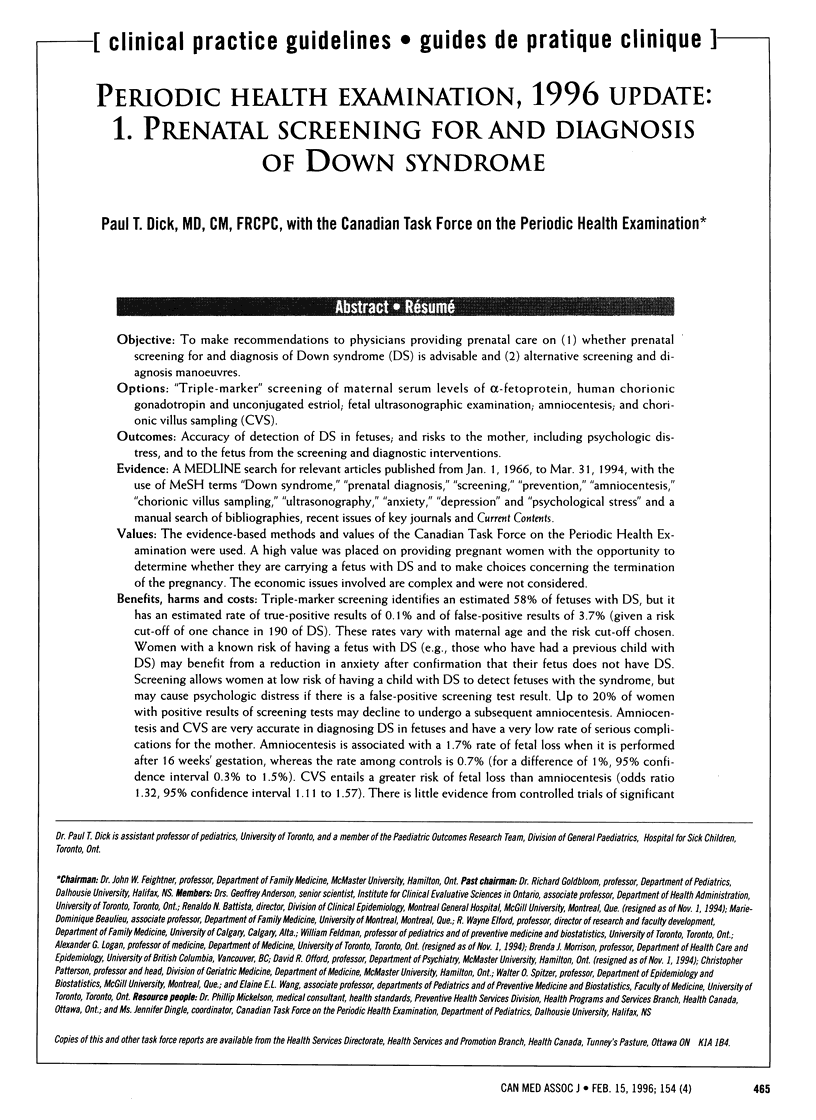
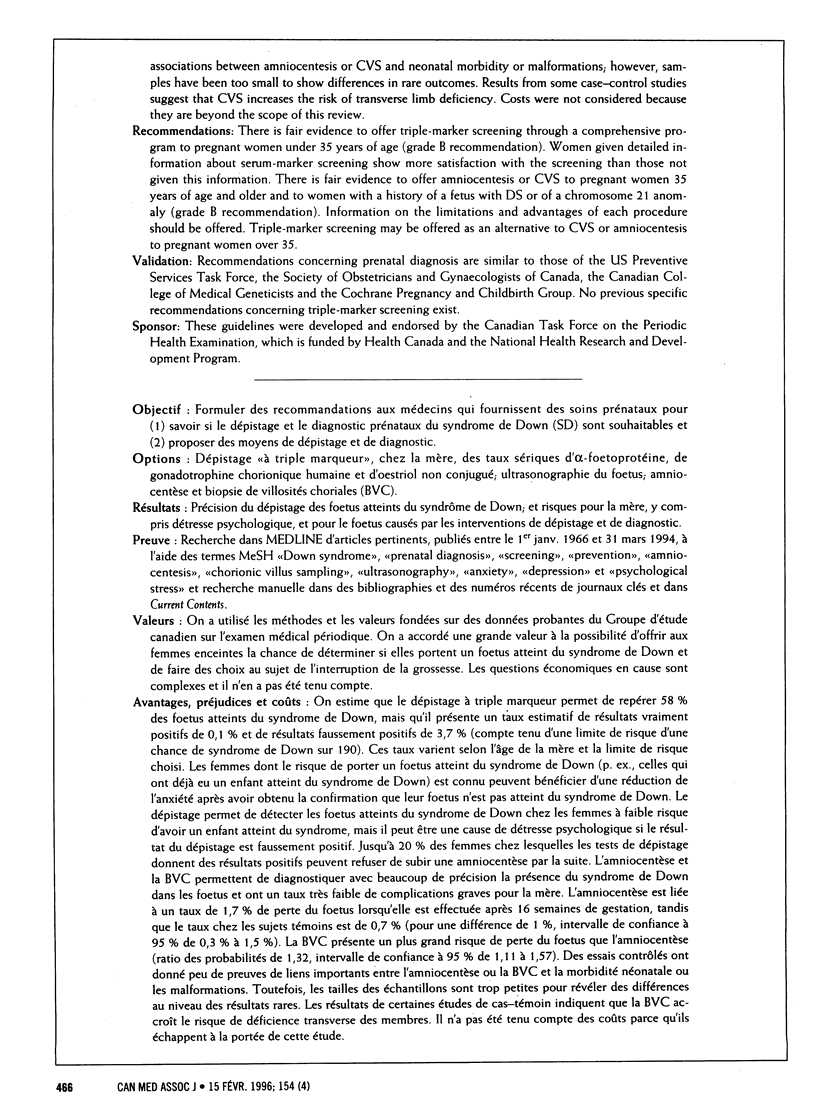
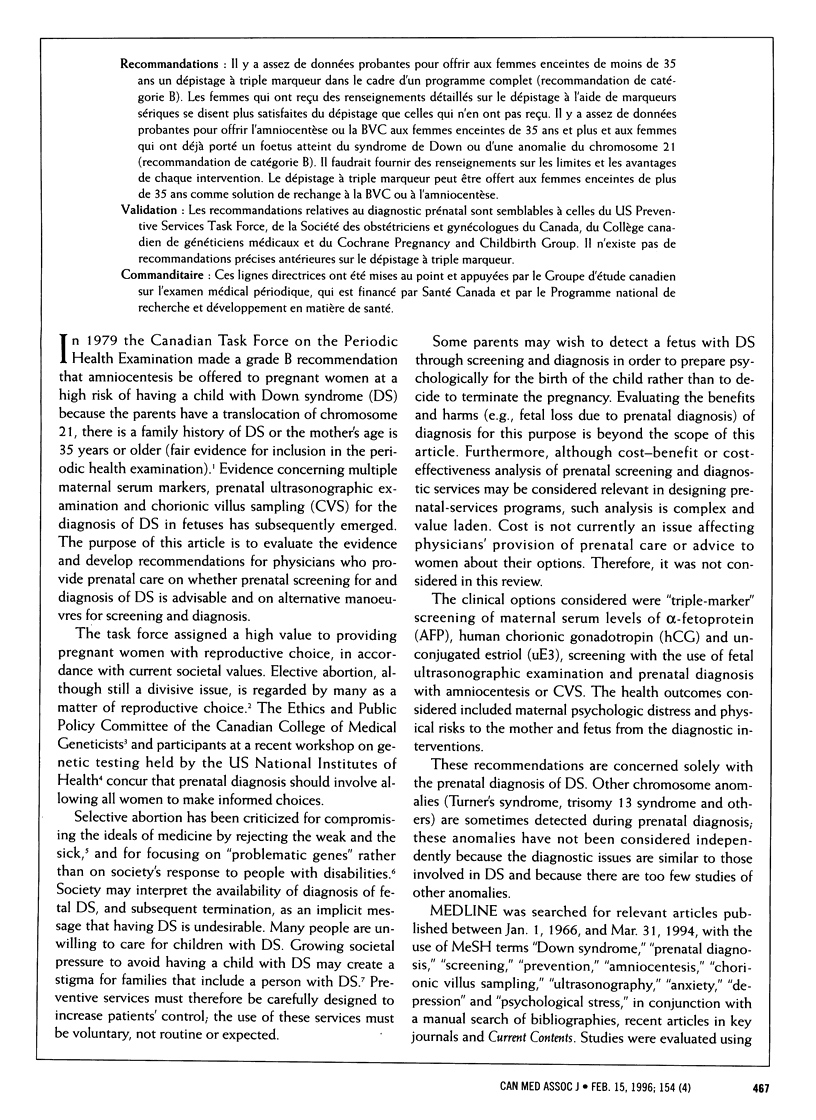
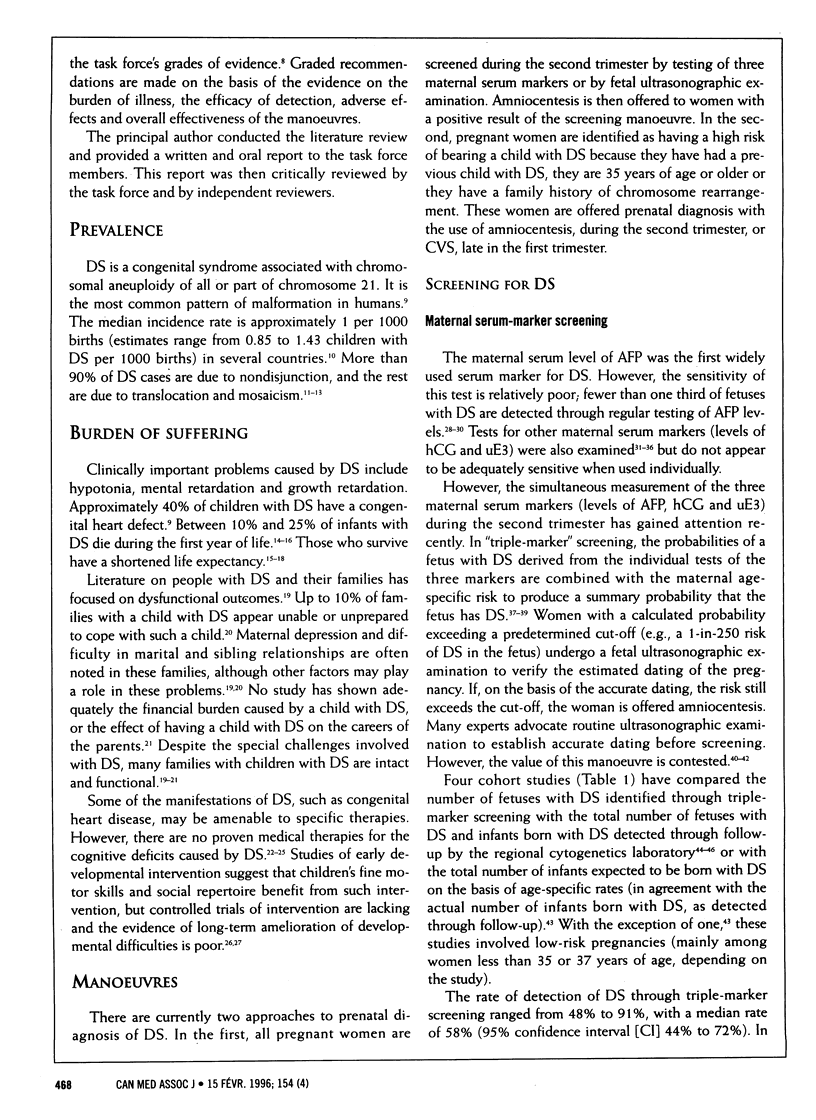

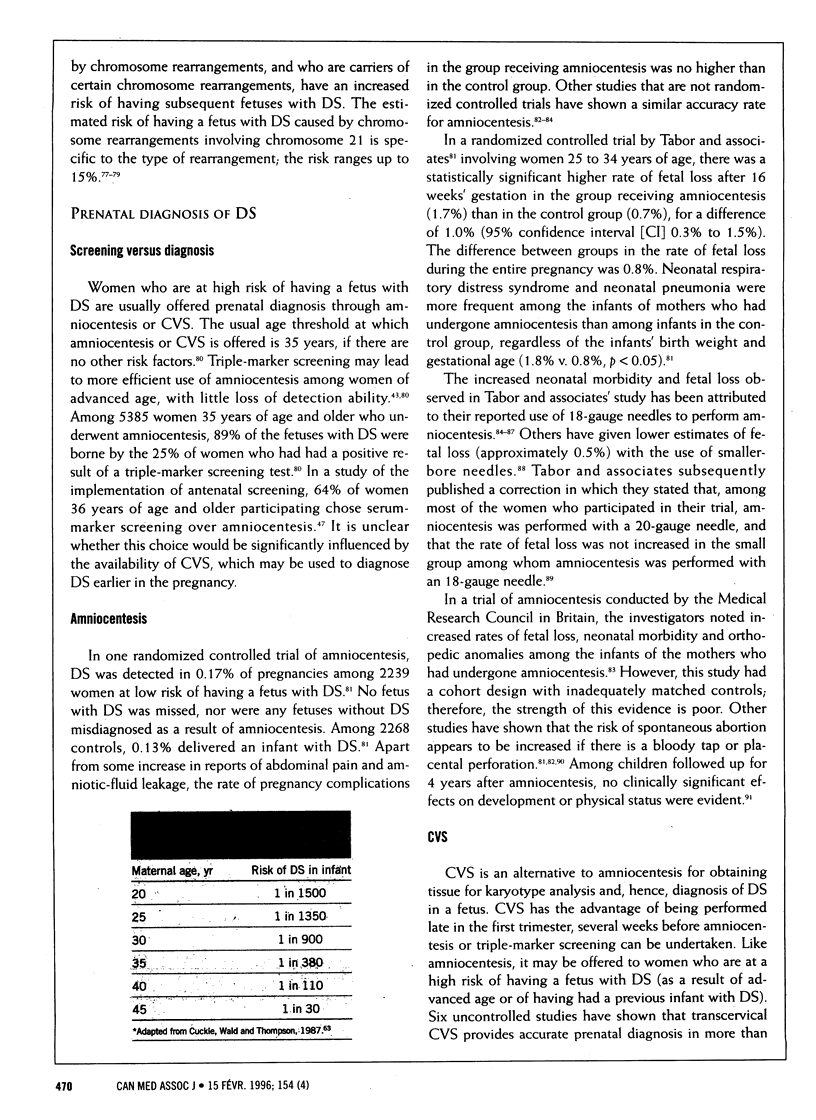
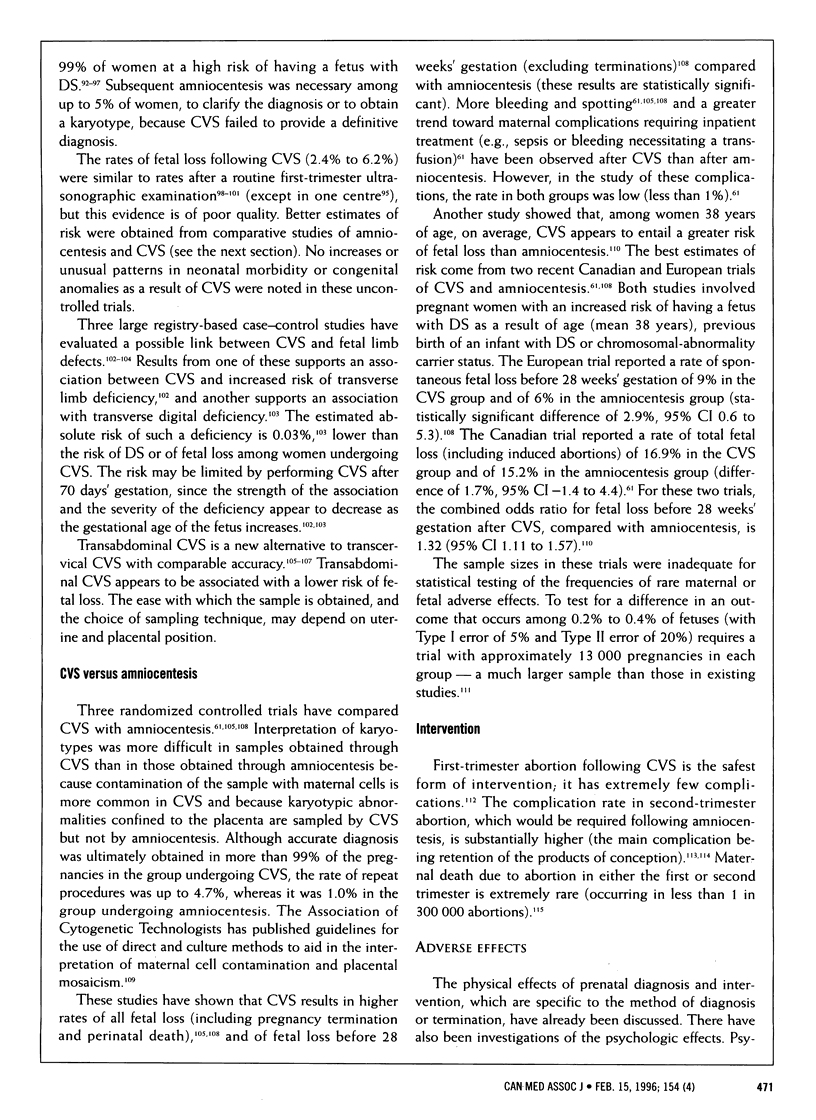
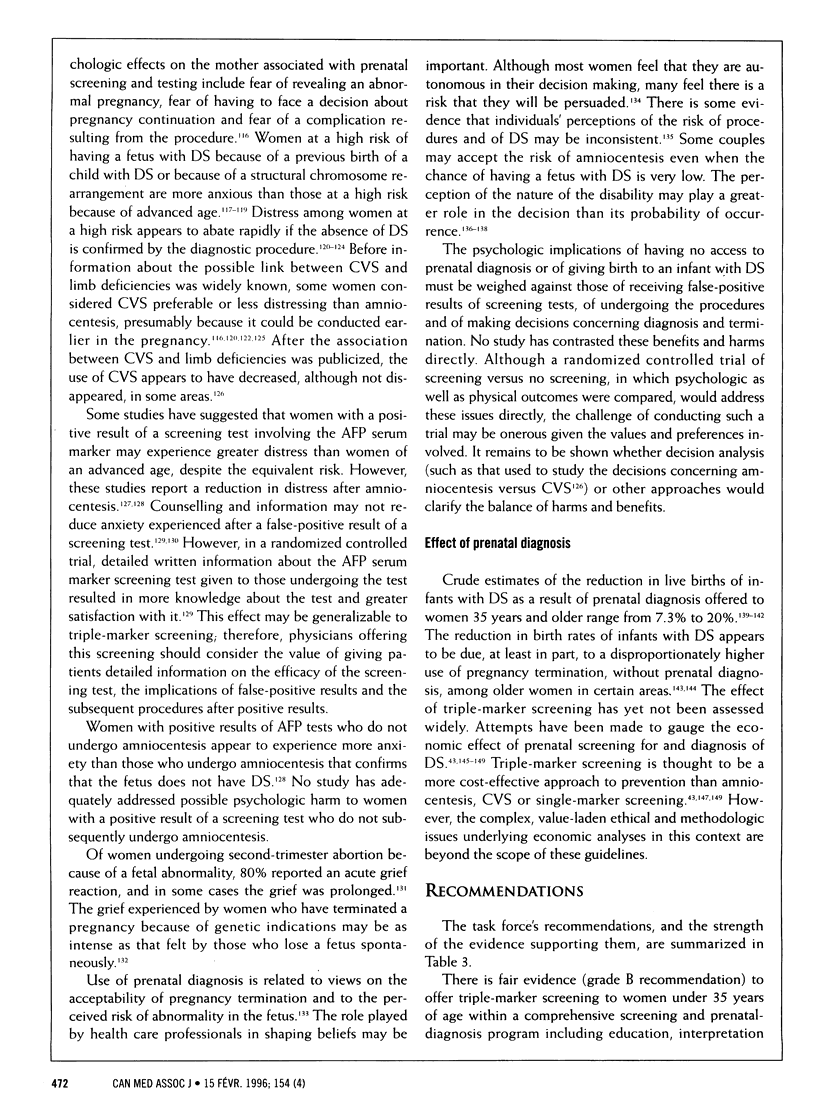
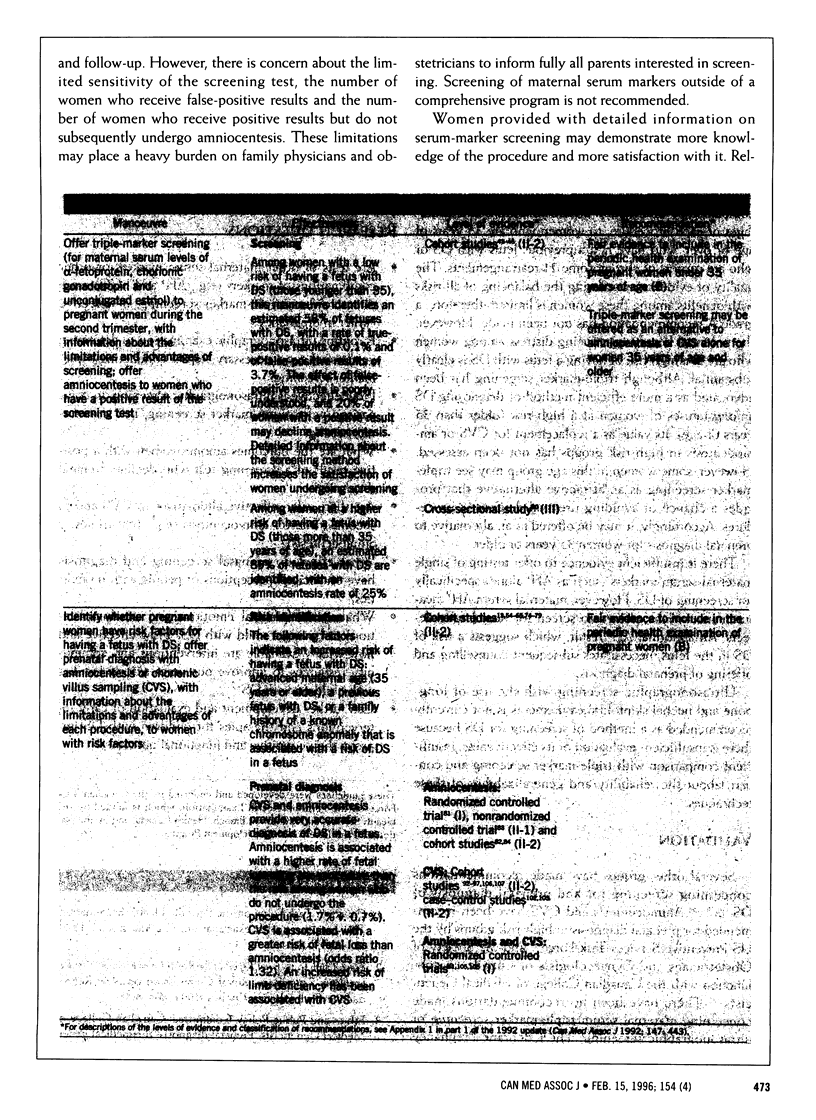
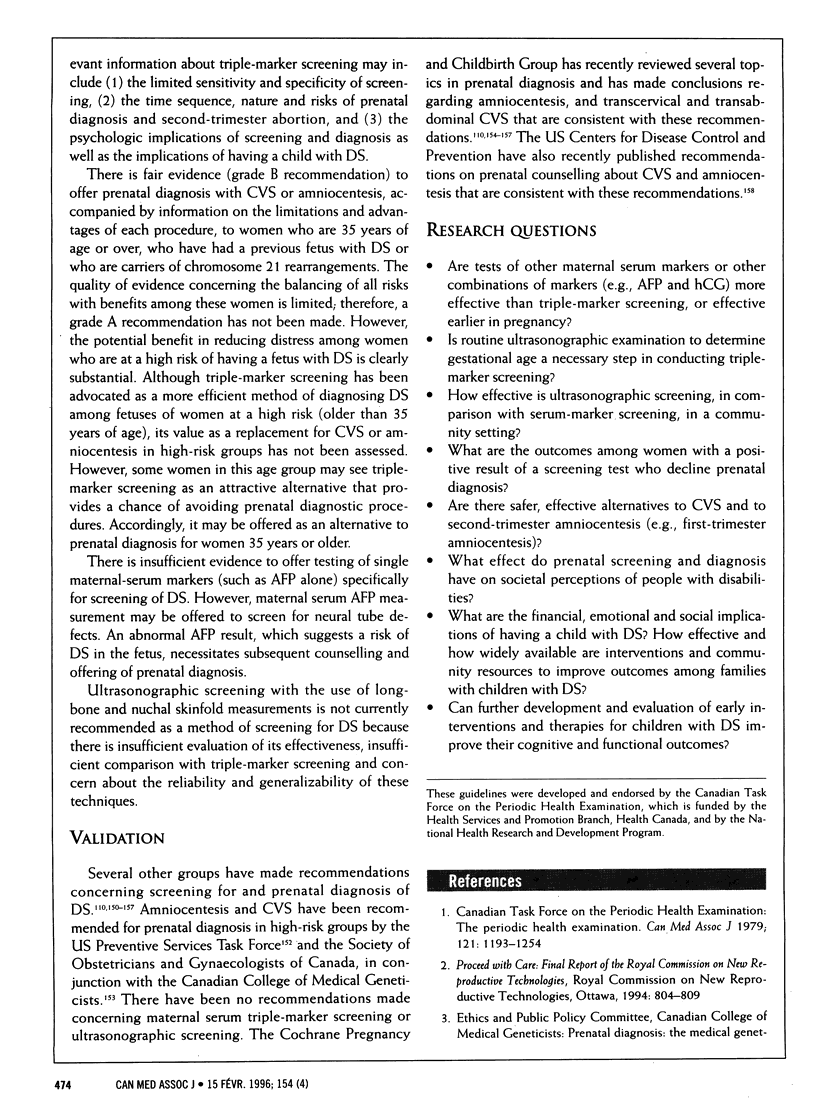
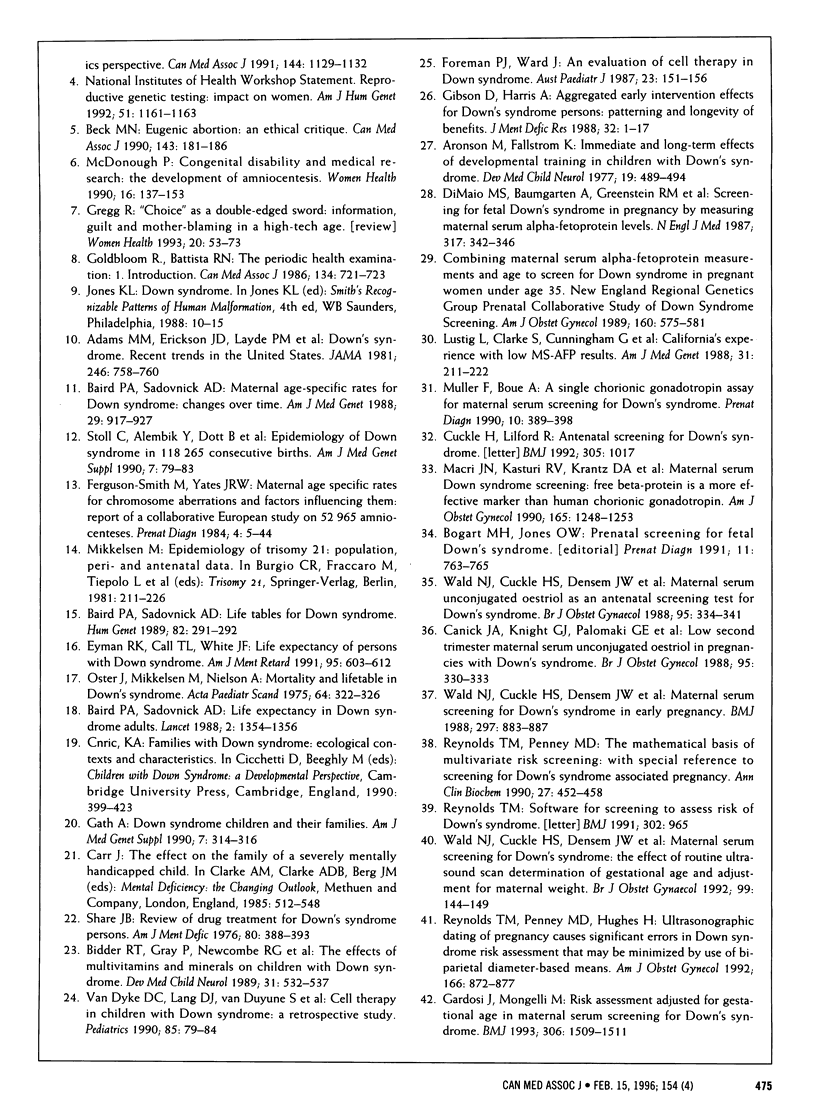

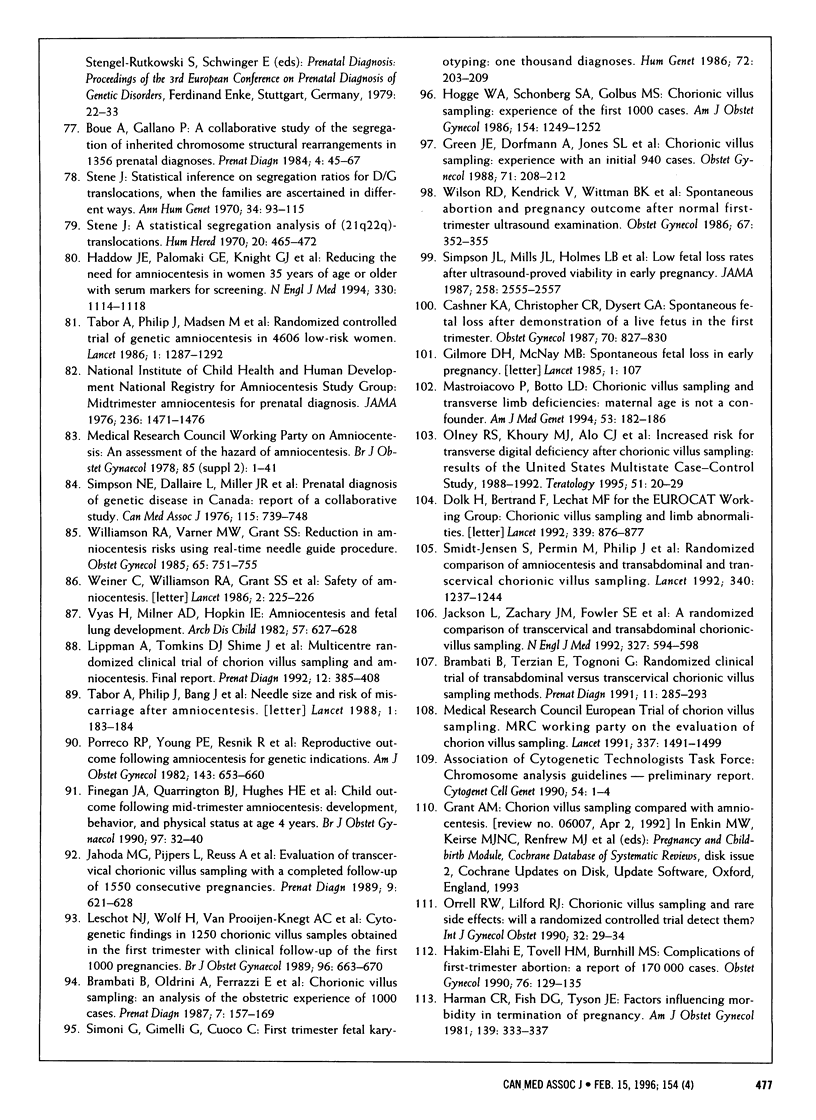
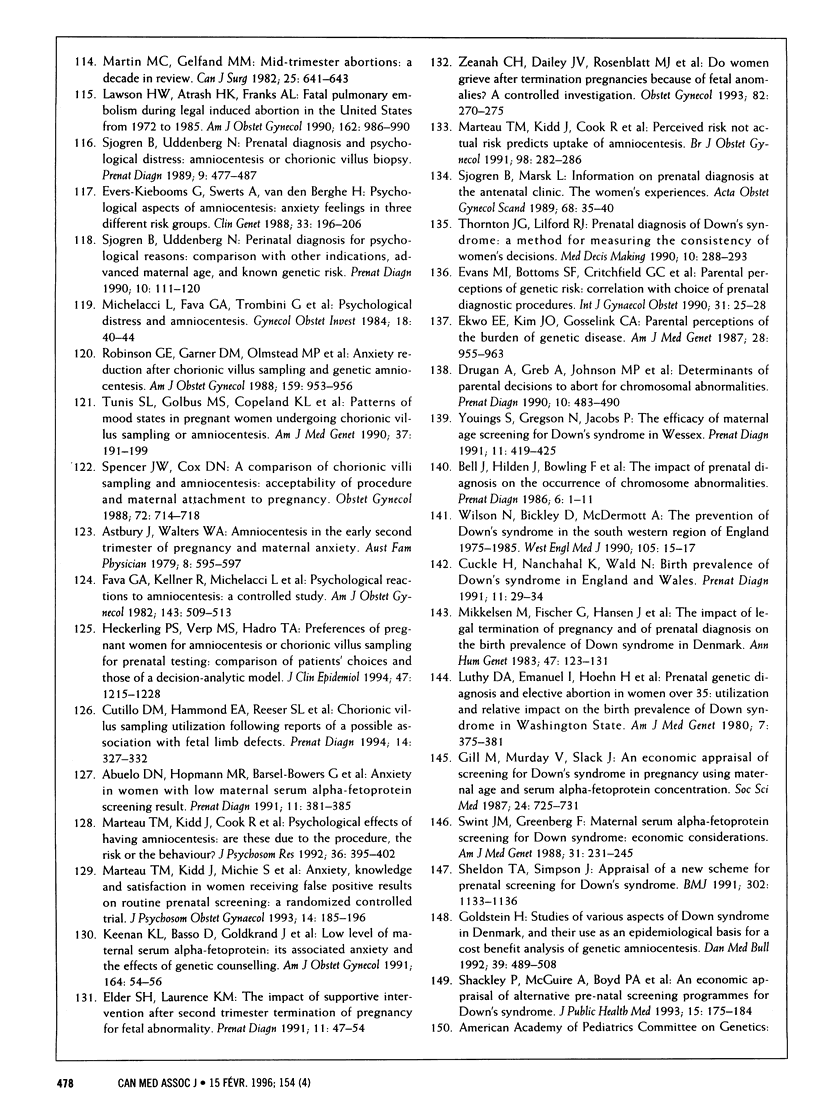
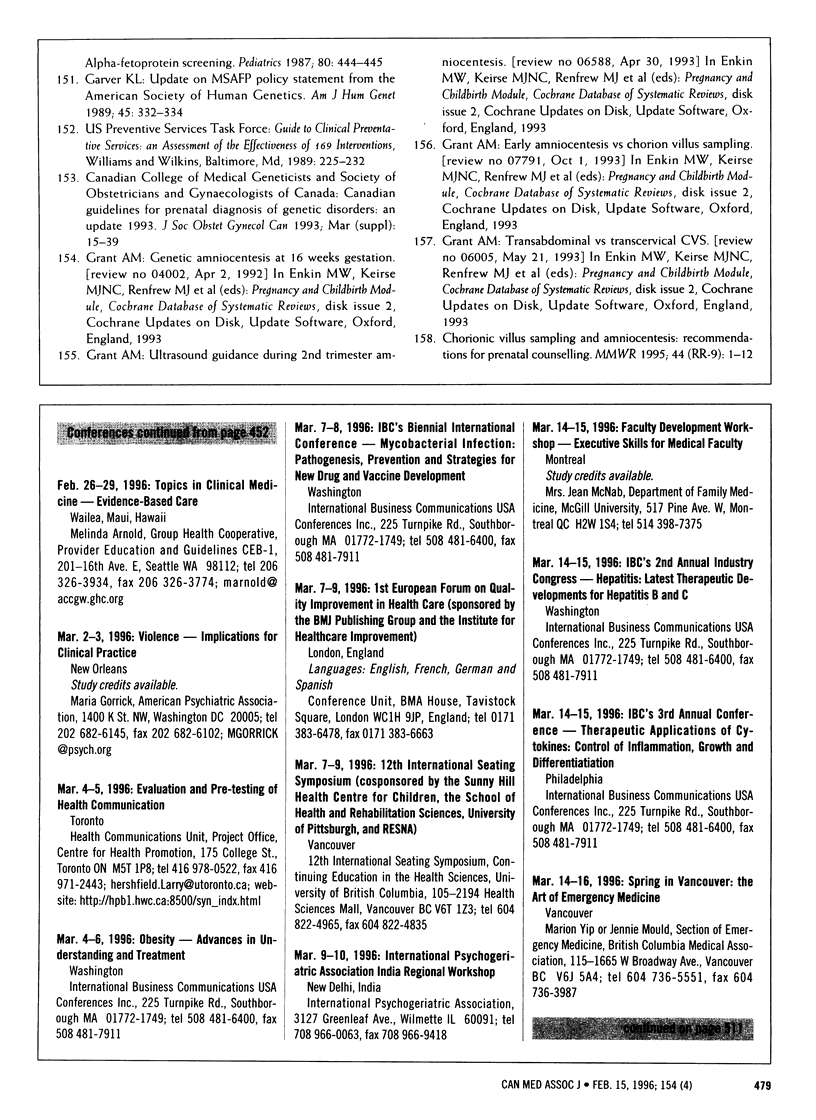
Selected References
These references are in PubMed. This may not be the complete list of references from this article.
- Abuelo D. N., Hopmann M. R., Barsel-Bowers G., Goldstein A. Anxiety in women with low maternal serum alpha-fetoprotein screening results. Prenat Diagn. 1991 Jun;11(6):381–385. doi: 10.1002/pd.1970110607. [DOI] [PubMed] [Google Scholar]
- Adams M. M., Erickson J. D., Layde P. M., Oakley G. P. Down's syndrome. Recent trends in the United States. JAMA. 1981 Aug 14;246(7):758–760. doi: 10.1001/jama.246.7.758. [DOI] [PubMed] [Google Scholar]
- Aronson M., Fällström K. Immediate and long-term effects of developmental training in children with Down's syndrome. Dev Med Child Neurol. 1977 Aug;19(4):489–494. doi: 10.1111/j.1469-8749.1977.tb07942.x. [DOI] [PubMed] [Google Scholar]
- Astbury J., Walters W. A. Amniocentesis in the early second trimester of pregnancy and maternal anxiety. Aust Fam Physician. 1979 Jun;8(6):595-7, 599. [PubMed] [Google Scholar]
- Baird P. A., Sadovnick A. D. Life expectancy in Down syndrome adults. Lancet. 1988 Dec 10;2(8624):1354–1356. doi: 10.1016/s0140-6736(88)90881-1. [DOI] [PubMed] [Google Scholar]
- Baird P. A., Sadovnick A. D. Life tables for Down syndrome. Hum Genet. 1989 Jun;82(3):291–292. doi: 10.1007/BF00291175. [DOI] [PubMed] [Google Scholar]
- Baird P. A., Sadovnick A. D. Maternal age-specific rates for Down syndrome: changes over time. Am J Med Genet. 1988 Apr;29(4):917–927. doi: 10.1002/ajmg.1320290424. [DOI] [PubMed] [Google Scholar]
- Beck M. N. Eugenic abortion: an ethical critique. CMAJ. 1990 Aug 1;143(3):181–186. [PMC free article] [PubMed] [Google Scholar]
- Bell J., Hilden J., Bowling F., Pearn J., Brownlea A., Martin N. The impact of prenatal diagnosis on the occurrence of chromosome abnormalities. Prenat Diagn. 1986 Jan-Feb;6(1):1–11. doi: 10.1002/pd.1970060102. [DOI] [PubMed] [Google Scholar]
- Bidder R. T., Gray P., Newcombe R. G., Evans B. K., Hughes M. The effects of multivitamins and minerals on children with Down syndrome. Dev Med Child Neurol. 1989 Aug;31(4):532–537. doi: 10.1111/j.1469-8749.1989.tb04032.x. [DOI] [PubMed] [Google Scholar]
- Bogart M. H., Jones O. W. Prenatal screening for fetal Down's syndrome. Prenat Diagn. 1991 Oct;11(10):763–765. doi: 10.1002/pd.1970111004. [DOI] [PubMed] [Google Scholar]
- Boué A., Gallano P. A collaborative study of the segregation of inherited chromosome structural rearrangements in 1356 prenatal diagnoses. Prenat Diagn. 1984 Spring;4(Spec No):45–67. doi: 10.1002/pd.1970040705. [DOI] [PubMed] [Google Scholar]
- Brambati B., Oldrini A., Ferrazzi E., Lanzani A. Chorionic villus sampling: an analysis of the obstetric experience of 1,000 cases. Prenat Diagn. 1987 Mar;7(3):157–169. doi: 10.1002/pd.1970070303. [DOI] [PubMed] [Google Scholar]
- Brambati B., Terzian E., Tognoni G. Randomized clinical trial of transabdominal versus transcervical chorionic villus sampling methods. Prenat Diagn. 1991 May;11(5):285–293. doi: 10.1002/pd.1970110503. [DOI] [PubMed] [Google Scholar]
- Canick J. A., Knight G. J., Palomaki G. E., Haddow J. E., Cuckle H. S., Wald N. J. Low second trimester maternal serum unconjugated oestriol in pregnancies with Down's syndrome. Br J Obstet Gynaecol. 1988 Apr;95(4):330–333. doi: 10.1111/j.1471-0528.1988.tb06601.x. [DOI] [PubMed] [Google Scholar]
- Cashner K. A., Christopher C. R., Dysert G. A. Spontaneous fetal loss after demonstration of a live fetus in the first trimester. Obstet Gynecol. 1987 Dec;70(6):827–830. [PubMed] [Google Scholar]
- Cheng E. Y., Luthy D. A., Zebelman A. M., Williams M. A., Lieppman R. E., Hickok D. E. A prospective evaluation of a second-trimester screening test for fetal Down syndrome using maternal serum alpha-fetoprotein, hCG, and unconjugated estriol. Obstet Gynecol. 1993 Jan;81(1):72–77. [PubMed] [Google Scholar]
- Crane J. P., Gray D. L. Sonographically measured nuchal skinfold thickness as a screening tool for Down syndrome: results of a prospective clinical trial. Obstet Gynecol. 1991 Apr;77(4):533–536. [PubMed] [Google Scholar]
- Cross P. K., Hook E. B. An analysis of paternal age and 47,+21 in 35,000 new prenatal cytogenetic diagnosis data from the New York State Chromosome Registry: no significant effect. Hum Genet. 1987 Dec;77(4):307–316. doi: 10.1007/BF00291415. [DOI] [PubMed] [Google Scholar]
- Cuckle H. S., Wald N. J., Thompson S. G. Estimating a woman's risk of having a pregnancy associated with Down's syndrome using her age and serum alpha-fetoprotein level. Br J Obstet Gynaecol. 1987 May;94(5):387–402. doi: 10.1111/j.1471-0528.1987.tb03115.x. [DOI] [PubMed] [Google Scholar]
- Cuckle H., Lilford R. Antenatal screening for Down's syndrome. BMJ. 1992 Oct 24;305(6860):1017–1017. doi: 10.1136/bmj.305.6860.1017. [DOI] [PMC free article] [PubMed] [Google Scholar]
- Cuckle H., Nanchahal K., Wald N. Birth prevalence of Down's syndrome in England and Wales. Prenat Diagn. 1991 Jan;11(1):29–34. doi: 10.1002/pd.1970110106. [DOI] [PubMed] [Google Scholar]
- Cutillo D. M., Hammond E. A., Reeser S. L., Kershner M. A., Lukin B., Godmilow L., Donnenfeld A. E. Chorionic villus sampling utilization following reports of a possible association with fetal limb defects. Prenat Diagn. 1994 May;14(5):327–332. doi: 10.1002/pd.1970140502. [DOI] [PubMed] [Google Scholar]
- DiMaio M. S., Baumgarten A., Greenstein R. M., Saal H. M., Mahoney M. J. Screening for fetal Down's syndrome in pregnancy by measuring maternal serum alpha-fetoprotein levels. N Engl J Med. 1987 Aug 6;317(6):342–346. doi: 10.1056/NEJM198708063170603. [DOI] [PubMed] [Google Scholar]
- Dolk H., Bertrand F., Lechat M. F. Chorionic villus sampling and limb abnormalities. The EUROCAT Working Group. Lancet. 1992 Apr 4;339(8797):876–877. doi: 10.1016/0140-6736(92)90325-w. [DOI] [PubMed] [Google Scholar]
- Drugan A., Greb A., Johnson M. P., Krivchenia E. L., Uhlmann W. R., Moghissi K. S., Evans M. I. Determinants of parental decisions to abort for chromosome abnormalities. Prenat Diagn. 1990 Aug;10(8):483–490. doi: 10.1002/pd.1970100802. [DOI] [PubMed] [Google Scholar]
- Ekwo E. E., Kim J. O., Gosselink C. A. Parental perceptions of the burden of genetic disease. Am J Med Genet. 1987 Dec;28(4):955–963. doi: 10.1002/ajmg.1320280422. [DOI] [PubMed] [Google Scholar]
- Elder S. H., Laurence K. M. The impact of supportive intervention after second trimester termination of pregnancy for fetal abnormality. Prenat Diagn. 1991 Jan;11(1):47–54. doi: 10.1002/pd.1970110109. [DOI] [PubMed] [Google Scholar]
- Evans M. I., Bottoms S. F., Critchfield G. C., Greb A., LaFerla J. J. Parental perceptions of genetic risk: correlation with choice of prenatal diagnostic procedures. Int J Gynaecol Obstet. 1990 Jan;31(1):25–28. doi: 10.1016/0020-7292(90)90177-m. [DOI] [PubMed] [Google Scholar]
- Evers-Kiebooms G., Swerts A., van den Berghe H. Psychological aspects of amniocentesis: anxiety feelings in three different risk groups. Clin Genet. 1988 Mar;33(3):196–206. doi: 10.1111/j.1399-0004.1988.tb03437.x. [DOI] [PubMed] [Google Scholar]
- Eyman R. K., Call T. L. Life expectancy of persons with Down syndrome. Am J Ment Retard. 1991 May;95(6):603–612. [PubMed] [Google Scholar]
- Fava G. A., Kellner R., Michelacci L., Trombini G., Pathak D., Orlandi C., Bovicelli L. Psychological reactions to amniocentesis: a controlled study. Am J Obstet Gynecol. 1982 Jul 1;143(5):509–513. doi: 10.1016/0002-9378(82)90538-5. [DOI] [PubMed] [Google Scholar]
- Ferguson-Smith M. A., Yates J. R. Maternal age specific rates for chromosome aberrations and factors influencing them: report of a collaborative european study on 52 965 amniocenteses. Prenat Diagn. 1984 Spring;4(Spec No):5–44. doi: 10.1002/pd.1970040704. [DOI] [PubMed] [Google Scholar]
- Finegan J. A., Quarrington B. J., Hughes H. E., Mervyn J. M., Hood J. E., Zacher J. E., Boyden M. Child outcome following mid-trimester amniocentesis: development, behaviour, and physical status at age 4 years. Br J Obstet Gynaecol. 1990 Jan;97(1):32–40. doi: 10.1111/j.1471-0528.1990.tb01713.x. [DOI] [PubMed] [Google Scholar]
- Foreman P. J., Ward J. An evaluation of cell therapy in Down syndrome. Aust Paediatr J. 1987 Jun;23(3):151–156. doi: 10.1111/j.1440-1754.1987.tb00234.x. [DOI] [PubMed] [Google Scholar]
- Gardosi J., Mongelli M. Risk assessment adjusted for gestational age in maternal serum screening for Down's syndrome. BMJ. 1993 Jun 5;306(6891):1509–1511. doi: 10.1136/bmj.306.6891.1509. [DOI] [PMC free article] [PubMed] [Google Scholar]
- Garver K. L. Update on MSAFP policy statement from the American Society of Human Genetics. Am J Hum Genet. 1989 Aug;45(2):332–334. [PMC free article] [PubMed] [Google Scholar]
- Gath A. Down syndrome children and their families. Am J Med Genet Suppl. 1990;7:314–316. doi: 10.1002/ajmg.1320370762. [DOI] [PubMed] [Google Scholar]
- Gibson D., Harris A. Aggregated early intervention effects for Down's syndrome persons: patterning and longevity of benefits. J Ment Defic Res. 1988 Feb;32(Pt 1):1–17. doi: 10.1111/j.1365-2788.1988.tb01384.x. [DOI] [PubMed] [Google Scholar]
- Gill M., Murday V., Slack J. An economic appraisal of screening for Down's syndrome in pregnancy using maternal age and serum alpha fetoprotein concentration. Soc Sci Med. 1987;24(9):725–731. doi: 10.1016/0277-9536(87)90109-2. [DOI] [PubMed] [Google Scholar]
- Gilmore D. H., McNay M. B. Spontaneous fetal loss rate in early pregnancy. Lancet. 1985 Jan 12;1(8420):107–107. doi: 10.1016/s0140-6736(85)91997-x. [DOI] [PubMed] [Google Scholar]
- Goldbloom R., Battista R. N. The periodic health examination: 1. Introduction. CMAJ. 1986 Apr 1;134(7):721–723. [PMC free article] [PubMed] [Google Scholar]
- Goldstein H. Studies of various aspects of Down syndrome in Denmark, and their use as an epidemiological basis for a cost benefit analysis of genetic amniocentesis. Dan Med Bull. 1992 Dec;39(6):489–508. [PubMed] [Google Scholar]
- Grandjean H., Sarramon M. F. Sonographic measurement of nuchal skinfold thickness for detection of Down syndrome in the second-trimester fetus: a multicenter prospective study. The AFDPHE Study Group. Association Française pour le Dépistage et la Prévention des Handicaps de l'Enfant. Obstet Gynecol. 1995 Jan;85(1):103–106. doi: 10.1016/0029-7844(94)00327-a. [DOI] [PubMed] [Google Scholar]
- Green J. E., Dorfmann A., Jones S. L., Bender S., Patton L., Schulman J. D. Chorionic villus sampling: experience with an initial 940 cases. Obstet Gynecol. 1988 Feb;71(2):208–212. [PubMed] [Google Scholar]
- Gregg R. "Choice" as a double-edged sword: information, guilt and mother-blaming in a high-tech age. Women Health. 1993;20(3):53–73. doi: 10.1300/J013v20n03_04. [DOI] [PubMed] [Google Scholar]
- Haddow J. E., Palomaki G. E., Knight G. J., Cunningham G. C., Lustig L. S., Boyd P. A. Reducing the need for amniocentesis in women 35 years of age or older with serum markers for screening. N Engl J Med. 1994 Apr 21;330(16):1114–1118. doi: 10.1056/NEJM199404213301603. [DOI] [PubMed] [Google Scholar]
- Haddow J. E., Palomaki G. E., Knight G. J., Williams J., Pulkkinen A., Canick J. A., Saller D. N., Jr, Bowers G. B. Prenatal screening for Down's syndrome with use of maternal serum markers. N Engl J Med. 1992 Aug 27;327(9):588–593. doi: 10.1056/NEJM199208273270902. [DOI] [PubMed] [Google Scholar]
- Hakim-Elahi E., Tovell H. M., Burnhill M. S. Complications of first-trimester abortion: a report of 170,000 cases. Obstet Gynecol. 1990 Jul;76(1):129–135. [PubMed] [Google Scholar]
- Harman C. R., Fish D. G., Tyson J. E. Factors influencing morbidity in termination of pregnancy. Am J Obstet Gynecol. 1981 Feb 1;139(3):333–337. doi: 10.1016/0002-9378(81)90021-1. [DOI] [PubMed] [Google Scholar]
- Heckerling P. S., Verp M. S., Hadro T. A. Preferences of pregnant women for amniocentesis or chorionic villus sampling for prenatal testing: comparison of patients' choices and those of a decision-analytic model. J Clin Epidemiol. 1994 Nov;47(11):1215–1228. doi: 10.1016/0895-4356(94)90126-0. [DOI] [PubMed] [Google Scholar]
- Hill L. M., Guzick D., Belfar H. L., Hixson J., Rivello D., Rusnak J. The current role of sonography in the detection of Down syndrome. Obstet Gynecol. 1989 Oct;74(4):620–623. [PubMed] [Google Scholar]
- Hogge W. A., Schonberg S. A., Golbus M. S. Chorionic villus sampling: experience of the first 1000 cases. Am J Obstet Gynecol. 1986 Jun;154(6):1249–1252. doi: 10.1016/0002-9378(86)90707-6. [DOI] [PubMed] [Google Scholar]
- Hook E. B., Chambers G. M. Estimated rates of Down syndrome in live births by one year maternal age intervals for mothers aged 20-49 in a New York State study-implications of the risk figures for genetic counseling and cost-benefit analysis of prenatal diagnosis programs. Birth Defects Orig Artic Ser. 1977;13(3A):123–141. [PubMed] [Google Scholar]
- Hook E. B., Cross P. K. Paternal age and Down's syndrome genotypes diagnosed prenatally: no association in New York state data. Hum Genet. 1982;62(2):167–174. doi: 10.1007/BF00282309. [DOI] [PubMed] [Google Scholar]
- Hook E. B. Differences between rates of trisomy 21 (Down syndrome) and other chromosomal abnormalities diagnosed in livebirths and in cells cultured after second-trimester amniocentesis--suggested explanations and implications for genetic counseling and program planning. Birth Defects Orig Artic Ser. 1978;14(6C):249–267. [PubMed] [Google Scholar]
- Hook E. B., Fabia J. J. Frequency of Down syndrome in livebirths by single-year maternal age interval: results of a Massachusetts study. Teratology. 1978 Jun;17(3):223–228. doi: 10.1002/tera.1420170303. [DOI] [PubMed] [Google Scholar]
- Hook E. B. Issues in analysis of data on paternal age and 47,+21: implications for genetic counseling for Down syndrome. Hum Genet. 1987 Dec;77(4):303–306. doi: 10.1007/BF00291414. [DOI] [PubMed] [Google Scholar]
- Hook E. B., Lindsjö A. Down syndrome in live births by single year maternal age interval in a Swedish study: comparison with results from a New York State study. Am J Hum Genet. 1978 Jan;30(1):19–27. [PMC free article] [PubMed] [Google Scholar]
- Hook E. B. Rates of chromosome abnormalities at different maternal ages. Obstet Gynecol. 1981 Sep;58(3):282–285. [PubMed] [Google Scholar]
- Hook E. B., Topol B. B., Cross P. K. The natural history of cytogenetically abnormal fetuses detected at midtrimester amniocentesis which are not terminated electively: new data and estimates of the excess and relative risk of late fetal death associated with 47,+21 and some other abnormal karyotypes. Am J Hum Genet. 1989 Dec;45(6):855–861. [PMC free article] [PubMed] [Google Scholar]
- Huether C. A., Gummere G. R., Hook E. B., Dignan P. S., Volodkevich H., Barg M., Ludwig D. A., Lamson S. H. Down's syndrome: percentage reporting on birth certificates and single year maternal age risk rates for Ohio 1970-79: comparison with upstate New York data. Am J Public Health. 1981 Dec;71(12):1367–1372. doi: 10.2105/ajph.71.12.1367. [DOI] [PMC free article] [PubMed] [Google Scholar]
- Jackson L. G., Zachary J. M., Fowler S. E., Desnick R. J., Golbus M. S., Ledbetter D. H., Mahoney M. J., Pergament E., Simpson J. L., Black S. A randomized comparison of transcervical and transabdominal chorionic-villus sampling. The U.S. National Institute of Child Health and Human Development Chorionic-Villus Sampling and Amniocentesis Study Group. N Engl J Med. 1992 Aug 27;327(9):594–598. doi: 10.1056/NEJM199208273270903. [DOI] [PubMed] [Google Scholar]
- Jahoda M. G., Pijpers L., Reuss A., Los F. J., Wladimiroff J. W., Sachs E. S. Evaluation of transcervical chorionic villus sampling with a completed follow-up of 1550 consecutive pregnancies. Prenat Diagn. 1989 Sep;9(9):621–628. doi: 10.1002/pd.1970090905. [DOI] [PubMed] [Google Scholar]
- Keenan K. L., Basso D., Goldkrand J., Butler W. J. Low level of maternal serum alpha-fetoprotein: its associated anxiety and the effects of genetic counseling. Am J Obstet Gynecol. 1991 Jan;164(1 Pt 1):54–56. doi: 10.1016/0002-9378(91)90624-z. [DOI] [PubMed] [Google Scholar]
- Koulischer L., Gillerot Y. Down's syndrome in Wallonia (South Belgium), 1971-1978: cytogenetics and incidence. Hum Genet. 1980;54(2):243–250. doi: 10.1007/BF00278979. [DOI] [PubMed] [Google Scholar]
- Lawson H. W., Atrash H. K., Franks A. L. Fatal pulmonary embolism during legal induced abortion in the United States from 1972 to 1985. Am J Obstet Gynecol. 1990 Apr;162(4):986–990. doi: 10.1016/0002-9378(90)91301-r. [DOI] [PubMed] [Google Scholar]
- Leschot N. J., Wolf H., Van Prooijen-Knegt A. C., van Asperen C. J., Verjaal M., Schuring-Blom G. H., Boer K., Kanhai H. H., Christiaens G. C. Cytogenetic findings in 1250 chorionic villus samples obtained in the first trimester with clinical follow-up of the first 1000 pregnancies. Br J Obstet Gynaecol. 1989 Jun;96(6):663–670. doi: 10.1111/j.1471-0528.1989.tb03280.x. [DOI] [PubMed] [Google Scholar]
- Lippman A., Tomkins D. J., Shime J., Hamerton J. L. Canadian multicentre randomized clinical trial of chorion villus sampling and amniocentesis. Final report. Prenat Diagn. 1992 May;12(5):385–408. doi: 10.1002/pd.1970120508. [DOI] [PubMed] [Google Scholar]
- Lustig L., Clarke S., Cunningham G., Schonberg R., Tompkinson G. California's experience with low MS-AFP results. Am J Med Genet. 1988 Sep;31(1):211–222. doi: 10.1002/ajmg.1320310128. [DOI] [PubMed] [Google Scholar]
- Luthy D. A., Emanuel I., Hoehn H., Hall J. G., Powers E. K. Prenatal genetic diagnosis and elective abortion in women over 35: utilization and relative impact on the birth prevalence of Down syndrome in Washington State. Am J Med Genet. 1980;7(3):375–381. doi: 10.1002/ajmg.1320070320. [DOI] [PubMed] [Google Scholar]
- Macri J. N., Kasturi R. V., Krantz D. A., Cook E. J., Moore N. D., Young J. A., Romero K., Larsen J. W., Jr Maternal serum Down syndrome screening: free beta-protein is a more effective marker than human chorionic gonadotropin. Am J Obstet Gynecol. 1990 Oct;163(4 Pt 1):1248–1253. doi: 10.1016/0002-9378(90)90700-h. [DOI] [PubMed] [Google Scholar]
- Marteau T. M., Kidd J., Cook R., Michie S., Johnston M., Slack J., Shaw R. W. Perceived risk not actual risk predicts uptake of amniocentesis. Br J Obstet Gynaecol. 1991 Mar;98(3):282–286. doi: 10.1111/j.1471-0528.1991.tb13394.x. [DOI] [PubMed] [Google Scholar]
- Marteau T. M., Kidd J., Cook R., Michie S., Johnston M., Slack J., Shaw R. W. Psychological effects of having amniocentesis: are these due to the procedure, the risk or the behaviour? J Psychosom Res. 1992 May;36(4):395–402. doi: 10.1016/0022-3999(92)90076-e. [DOI] [PubMed] [Google Scholar]
- Marteau T. M., Kidd J., Michie S., Cook R., Johnston M., Shaw R. W. Anxiety, knowledge and satisfaction in women receiving false positive results on routine prenatal screening: a randomized controlled trial. J Psychosom Obstet Gynaecol. 1993 Sep;14(3):185–196. doi: 10.3109/01674829309084441. [DOI] [PubMed] [Google Scholar]
- Martin M. C., Gelfand M. M. Mid-trimester abortions: a decade in review. Can J Surg. 1982 Nov;25(6):641–643. [PubMed] [Google Scholar]
- Mastroiacovo P., Botto L. D. Chorionic villus sampling and transverse limb deficiencies: maternal age is not a confounder. Am J Med Genet. 1994 Nov 1;53(2):182–186. doi: 10.1002/ajmg.1320530212. [DOI] [PubMed] [Google Scholar]
- Matsunaga E., Tonomura A., Oishi H., Kikuchi Y. Reexamination of paternal age effect in Down's syndrome. Hum Genet. 1978 Feb 16;40(3):259–268. doi: 10.1007/BF00272186. [DOI] [PubMed] [Google Scholar]
- McDonough P. Congenital disability and medical research: the development of amniocentesis. Women Health. 1990;16(3-4):137–153. doi: 10.1300/J013v16n03_08. [DOI] [PubMed] [Google Scholar]
- Michelacci L., Fava G. A., Trombini G., Zielezny M., Bovicelli L., Orlandi C. Psychological distress and amniocentesis. Gynecol Obstet Invest. 1984;18(1):40–44. doi: 10.1159/000299046. [DOI] [PubMed] [Google Scholar]
- Mikkelsen M. Epidemiology of trisomy 21: population, peri- and antenatal data. Hum Genet Suppl. 1981;2:211–226. doi: 10.1007/978-3-642-68006-9_16. [DOI] [PubMed] [Google Scholar]
- Mikkelsen M., Fischer G., Hansen J., Pilgaard B., Nielsen J. The impact of legal termination of pregnancy and of prenatal diagnosis on the birth prevalence of Down syndrome in Denmark. Ann Hum Genet. 1983 May;47(Pt 2):123–131. doi: 10.1111/j.1469-1809.1983.tb00979.x. [DOI] [PubMed] [Google Scholar]
- Muller F., Boué A. A single chorionic gonadotropin assay for maternal serum screening for Down's syndrome. Prenat Diagn. 1990 Jun;10(6):389–398. doi: 10.1002/pd.1970100606. [DOI] [PubMed] [Google Scholar]
- Nyberg D. A., Resta R. G., Luthy D. A., Hickok D. E., Mahony B. S., Hirsch J. H. Prenatal sonographic findings of Down syndrome: review of 94 cases. Obstet Gynecol. 1990 Sep;76(3 Pt 1):370–377. [PubMed] [Google Scholar]
- Olney R. S., Khoury M. J., Alo C. J., Costa P., Edmonds L. D., Flood T. J., Harris J. A., Howe H. L., Moore C. A., Olsen C. L. Increased risk for transverse digital deficiency after chorionic villus sampling: results of the United States Multistate Case-Control Study, 1988-1992. Teratology. 1995 Jan;51(1):20–29. doi: 10.1002/tera.1420510104. [DOI] [PubMed] [Google Scholar]
- Orrell R. W., Lilford R. J. Chorionic villus sampling and rare side-effects: will a randomised controlled trial detect them? Int J Gynaecol Obstet. 1990 May;32(1):29–34. doi: 10.1016/0020-7292(90)90978-t. [DOI] [PubMed] [Google Scholar]
- Oster J., Mikkelsen M., Nielsen A. Mortality and life-table in Down's syndrome. Acta Paediatr Scand. 1975 Mar;64(2):322–326. doi: 10.1111/j.1651-2227.1975.tb03842.x. [DOI] [PubMed] [Google Scholar]
- Phillips O. P., Elias S., Shulman L. P., Andersen R. N., Morgan C. D., Simpson J. L. Maternal serum screening for fetal Down syndrome in women less than 35 years of age using alpha-fetoprotein, hCG, and unconjugated estriol: a prospective 2-year study. Obstet Gynecol. 1992 Sep;80(3 Pt 1):353–358. [PubMed] [Google Scholar]
- Piggott M., Wilkinson P., Bennett J. Implementation of an antenatal serum screening programme for Down's syndrome in two districts (Brighton and Eastbourne). The Brighton and Eastbourne Down's Syndrome Screening Group. J Med Screen. 1994 Jan;1(1):45–49. doi: 10.1177/096914139400100109. [DOI] [PubMed] [Google Scholar]
- Porreco R. P., Young P. E., Resnik R., Cousins L., Jones O. W., Richards T., Kernahan C., Matson M. Reproductive outcome following amniocentesis for genetic indications. Am J Obstet Gynecol. 1982 Jul 15;143(6):653–660. doi: 10.1016/0002-9378(82)90110-7. [DOI] [PubMed] [Google Scholar]
- Reynolds T. M., Penney M. D., Hughes H. Ultrasonographic dating of pregnancy causes significant errors in Down syndrome risk assessment that may be minimized by use of biparietal diameter-based means. Am J Obstet Gynecol. 1992 Mar;166(3):872–877. doi: 10.1016/0002-9378(92)91353-c. [DOI] [PubMed] [Google Scholar]
- Reynolds T. M., Penney M. D. The mathematical basis of multivariate risk screening: with special reference to screening for Down's syndrome associated pregnancy. Ann Clin Biochem. 1990 Sep;27(Pt 5):452–458. doi: 10.1177/000456329002700506. [DOI] [PubMed] [Google Scholar]
- Reynolds T. M. Software for screening to assess risk of Down's syndrome. BMJ. 1991 Apr 20;302(6782):965–965. doi: 10.1136/bmj.302.6782.965. [DOI] [PMC free article] [PubMed] [Google Scholar]
- Robinson G. E., Garner D. M., Olmsted M. P., Shime J., Hutton E. M., Crawford B. M. Anxiety reduction after chorionic villus sampling and genetic amniocentesis. Am J Obstet Gynecol. 1988 Oct;159(4):953–956. doi: 10.1016/s0002-9378(88)80180-7. [DOI] [PubMed] [Google Scholar]
- Rotmensch S., Luo J. S., Liberati M., Belanger K., Mahoney M. J., Hobbins J. C. Fetal humeral length to detect Down syndrome. Am J Obstet Gynecol. 1992 May;166(5):1330–1334. doi: 10.1016/0002-9378(92)91599-6. [DOI] [PubMed] [Google Scholar]
- Shackley P., McGuire A., Boyd P. A., Dennis J., Fitchett M., Kay J., Roche M., Wood P. An economic appraisal of alternative pre-natal screening programmes for Down's syndrome. J Public Health Med. 1993 Jun;15(2):175–184. [PubMed] [Google Scholar]
- Share J. B. Review of drug treatment for Down's syndrome persons. Am J Ment Defic. 1976 Jan;80(4):388–393. [PubMed] [Google Scholar]
- Sheldon T. A., Simpson J. Appraisal of a new scheme for prenatal screening for Down's syndrome. BMJ. 1991 May 11;302(6785):1133–1136. doi: 10.1136/bmj.302.6785.1133. [DOI] [PMC free article] [PubMed] [Google Scholar]
- Simoni G., Gimelli G., Cuoco C., Romitti L., Terzoli G., Guerneri S., Rossella F., Pescetto L., Pezzolo A., Porta S. First trimester fetal karyotyping: one thousand diagnoses. Hum Genet. 1986 Mar;72(3):203–209. doi: 10.1007/BF00291878. [DOI] [PubMed] [Google Scholar]
- Simpson J. L., Mills J. L., Holmes L. B., Ober C. L., Aarons J., Jovanovic L., Knopp R. H. Low fetal loss rates after ultrasound-proved viability in early pregnancy. JAMA. 1987 Nov 13;258(18):2555–2557. [PubMed] [Google Scholar]
- Simpson N. E., Dallaire L., Miller J. R., Siminovich L., Hamerton J. L., Miller J., McKeen C. Prenatal diagnosis of genetic disease in Canada: report of a collaborative study. Can Med Assoc J. 1976 Oct 23;115(8):739–748. [PMC free article] [PubMed] [Google Scholar]
- Sjögren B., Marsk L. Information on prenatal diagnosis at the antenatal clinic. The women's experiences. Acta Obstet Gynecol Scand. 1989;68(1):35–40. doi: 10.3109/00016348909087686. [DOI] [PubMed] [Google Scholar]
- Sjögren B., Uddenberg N. Prenatal diagnosis and psychological distress: amniocentesis or chorionic villus biopsy? Prenat Diagn. 1989 Jul;9(7):477–487. doi: 10.1002/pd.1970090705. [DOI] [PubMed] [Google Scholar]
- Sjögren B., Uddenberg N. Prenatal diagnosis for psychological reasons: comparison with other indications, advanced maternal age and known genetic risk. Prenat Diagn. 1990 Feb;10(2):111–120. doi: 10.1002/pd.1970100207. [DOI] [PubMed] [Google Scholar]
- Smidt-Jensen S., Permin M., Philip J., Lundsteen C., Zachary J. M., Fowler S. E., Grüning K. Randomised comparison of amniocentesis and transabdominal and transcervical chorionic villus sampling. Lancet. 1992 Nov 21;340(8830):1237–1244. doi: 10.1016/0140-6736(92)92946-d. [DOI] [PubMed] [Google Scholar]
- Spencer J. W., Cox D. N. A comparison of chorionic villi sampling and amniocentesis: acceptability of procedure and maternal attachment to pregnancy. Obstet Gynecol. 1988 Nov;72(5):714–718. [PubMed] [Google Scholar]
- Stene E., Stene J., Stengel-Rutkowski S. A reanalysis of the New York State prenatal diagnosis data on Down's syndrome and paternal age effects. Hum Genet. 1987 Dec;77(4):299–302. doi: 10.1007/BF00291413. [DOI] [PubMed] [Google Scholar]
- Stene J. A statistical segregation analysis of (21q22q)-translocations. Hum Hered. 1970;20(5):465–472. doi: 10.1159/000152347. [DOI] [PubMed] [Google Scholar]
- Stene J. Detection of higher recurrence risk for age-dependent chromosome abnormalities with an application to trisomy G1. (Down's syndrome). Hum Hered. 1970;20(1):112–122. doi: 10.1159/000152301. [DOI] [PubMed] [Google Scholar]
- Stene J. Statistical inference on segregation ratios for D-G-translocations, when the families are ascertained in different ways. Ann Hum Genet. 1970 Jul;34(1):93–115. doi: 10.1111/j.1469-1809.1970.tb00224.x. [DOI] [PubMed] [Google Scholar]
- Stene J., Stene E., Stengel-Rutkowski S., Murken J. D. Paternal age and Down's syndrome: data from prenatal diagnoses (DFG). Hum Genet. 1981;59(2):119–124. doi: 10.1007/BF00293059. [DOI] [PubMed] [Google Scholar]
- Stoll C., Alembik Y., Dott B., Roth M. P. Epidemiology of Down syndrome in 118,265 consecutive births. Am J Med Genet Suppl. 1990;7:79–83. doi: 10.1002/ajmg.1320370715. [DOI] [PubMed] [Google Scholar]
- Sutherland G. R., Clisby S. R., Bloor G., Carter R. F. Down's syndrome in South Australia. Med J Aust. 1979 Jul 28;2(2):58–61. doi: 10.5694/j.1326-5377.1979.tb112703.x. [DOI] [PubMed] [Google Scholar]
- Swint J. M., Greenberg F. Maternal serum alpha-fetoprotein screening for Down syndrome: economic considerations. Am J Med Genet. 1988 Sep;31(1):231–245. doi: 10.1002/ajmg.1320310130. [DOI] [PubMed] [Google Scholar]
- Tabor A., Philip J., Bang J., Madsen M., Obel E. B., Nørgaard-Pedersen B. Needle size and risk of miscarriage after amniocentesis. Lancet. 1988 Jan 23;1(8578):183–184. doi: 10.1016/s0140-6736(88)92758-4. [DOI] [PubMed] [Google Scholar]
- Tabor A., Philip J., Madsen M., Bang J., Obel E. B., Nørgaard-Pedersen B. Randomised controlled trial of genetic amniocentesis in 4606 low-risk women. Lancet. 1986 Jun 7;1(8493):1287–1293. doi: 10.1016/s0140-6736(86)91218-3. [DOI] [PubMed] [Google Scholar]
- Thornton J. G., Lilford R. J. Prenatal diagnosis of Down's syndrome: a method for measuring the consistency of women's decisions. Med Decis Making. 1990 Oct-Dec;10(4):288–293. doi: 10.1177/0272989X9001000407. [DOI] [PubMed] [Google Scholar]
- Trimble B. K., Baird P. A. Maternal age and Down syndrome: age-specific incidence rates by single-year intervals. Am J Med Genet. 1978;2(1):1–5. doi: 10.1002/ajmg.1320020102. [DOI] [PubMed] [Google Scholar]
- Tunis S. L., Golbus M. S., Copeland K. L., Fine B. A., Rosinsky B. J., Seely L. Patterns of mood states in pregnant women undergoing chorionic villus sampling or amniocentesis. Am J Med Genet. 1990 Oct;37(2):191–199. doi: 10.1002/ajmg.1320370207. [DOI] [PubMed] [Google Scholar]
- Van Dyke D. C., Lang D. J., van Duyne S., Heide F., Chang H. J. Cell therapy in children with Down syndrome: a retrospective study. Pediatrics. 1990 Jan;85(1):79–84. [PubMed] [Google Scholar]
- Vyas H., Milner A. D., Hopkin I. E. Amniocentesis and fetal lung development. Arch Dis Child. 1982 Aug;57(8):627–628. doi: 10.1136/adc.57.8.627. [DOI] [PMC free article] [PubMed] [Google Scholar]
- Wald N. J., Cuckle H. S., Densem J. W., Kennard A., Smith D. Maternal serum screening for Down's syndrome: the effect of routine ultrasound scan determination of gestational age and adjustment for maternal weight. Br J Obstet Gynaecol. 1992 Feb;99(2):144–149. doi: 10.1111/j.1471-0528.1992.tb14474.x. [DOI] [PubMed] [Google Scholar]
- Wald N. J., Cuckle H. S., Densem J. W., Nanchahal K., Canick J. A., Haddow J. E., Knight G. J., Palomaki G. E. Maternal serum unconjugated oestriol as an antenatal screening test for Down's syndrome. Br J Obstet Gynaecol. 1988 Apr;95(4):334–341. doi: 10.1111/j.1471-0528.1988.tb06602.x. [DOI] [PubMed] [Google Scholar]
- Wald N. J., Cuckle H. S., Densem J. W., Nanchahal K., Royston P., Chard T., Haddow J. E., Knight G. J., Palomaki G. E., Canick J. A. Maternal serum screening for Down's syndrome in early pregnancy. BMJ. 1988 Oct 8;297(6653):883–887. doi: 10.1136/bmj.297.6653.883. [DOI] [PMC free article] [PubMed] [Google Scholar]
- Wald N. J., Kennard A., Densem J. W., Cuckle H. S., Chard T., Butler L. Antenatal maternal serum screening for Down's syndrome: results of a demonstration project. BMJ. 1992 Aug 15;305(6850):391–394. doi: 10.1136/bmj.305.6850.391. [DOI] [PMC free article] [PubMed] [Google Scholar]
- Williamson R. A., Varner M. W., Grant S. S. Reduction in amniocentesis risks using a real-time needle guide procedure. Obstet Gynecol. 1985 May;65(5):751–755. [PubMed] [Google Scholar]
- Wilson N., Bickley D., McDermott A. The prevention of Down's syndrome in the south western region of England 1975-1985. West Engl Med J. 1990 Mar;105(1):15–17. [PMC free article] [PubMed] [Google Scholar]
- Wilson R. D., Chitayat D., McGillivray B. C. Fetal ultrasound abnormalities: correlation with fetal karyotype, autopsy findings, and postnatal outcome--five-year prospective study. Am J Med Genet. 1992 Nov 15;44(5):586–590. doi: 10.1002/ajmg.1320440511. [DOI] [PubMed] [Google Scholar]
- Wilson R. D., Kendrick V., Wittmann B. K., McGillivray B. Spontaneous abortion and pregnancy outcome after normal first-trimester ultrasound examination. Obstet Gynecol. 1986 Mar;67(3):352–355. [PubMed] [Google Scholar]
- Youings S., Gregson N., Jacobs P. The efficacy of maternal age screening for Down's syndrome in Wessex. Prenat Diagn. 1991 Jul;11(7):419–425. doi: 10.1002/pd.1970110703. [DOI] [PubMed] [Google Scholar]
- Young I. D., Williams E. M., Newcombe R. G. Down syndrome and maternal age in South Glamorgan. J Med Genet. 1980 Dec;17(6):433–436. doi: 10.1136/jmg.17.6.433. [DOI] [PMC free article] [PubMed] [Google Scholar]
- Zeanah C. H., Dailey J. V., Rosenblatt M. J., Saller D. N., Jr Do women grieve after terminating pregnancies because of fetal anomalies? A controlled investigation. Obstet Gynecol. 1993 Aug;82(2):270–275. [PubMed] [Google Scholar]


